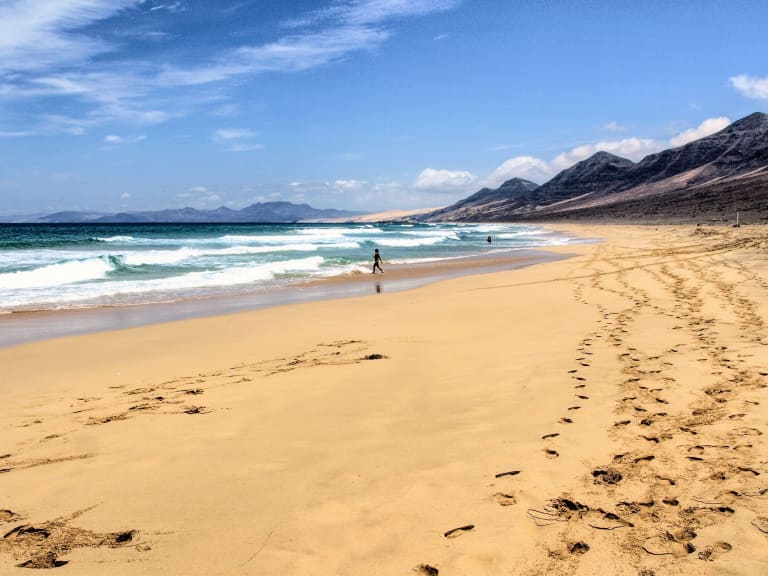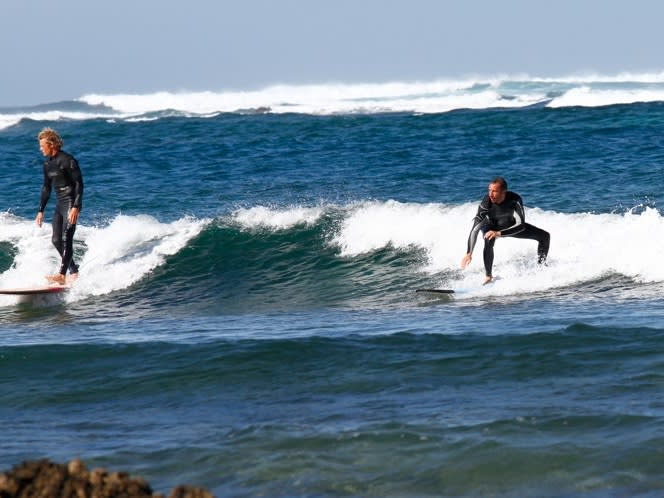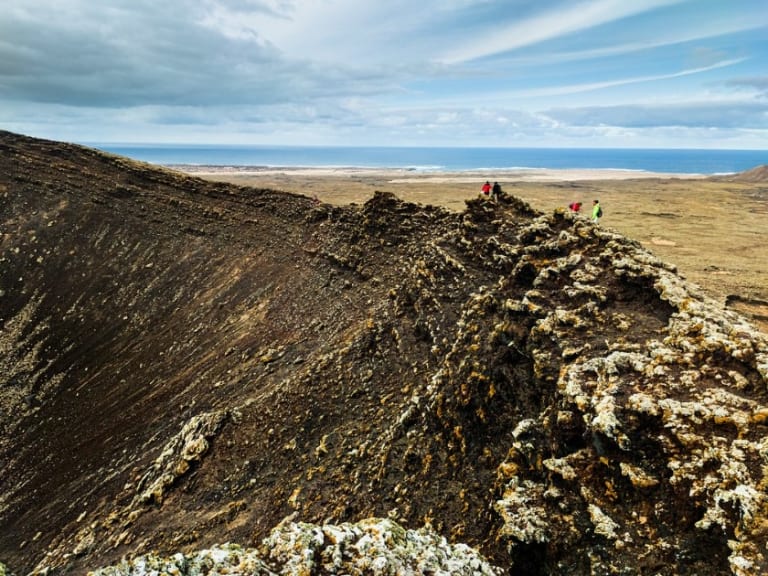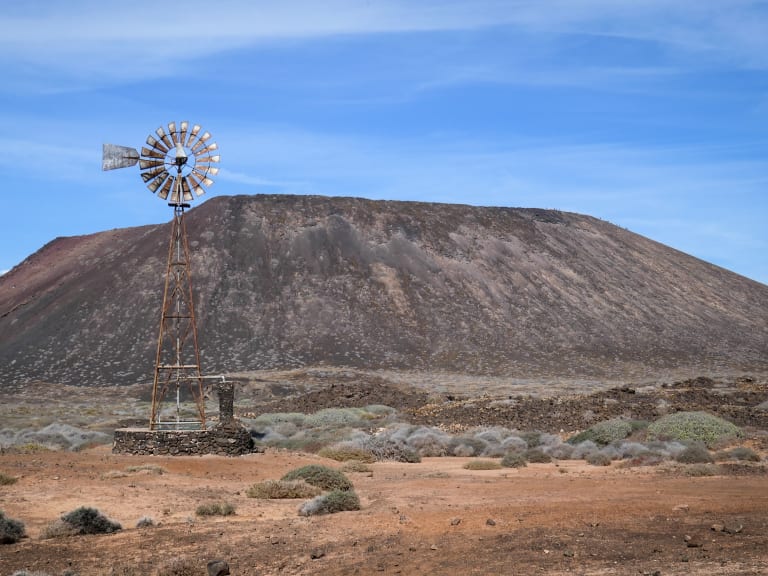More about: 10 Best Things to Do in Fuerteventura
Fuerteventura is the second largest island of the Canary archipelago and is worth a visit at any time of the year. It is a dream destination for surfers, but the waves are not its only attraction. The extreme landscapes and the succulent gastronomy attract a large number of Spaniards and foreigners to the island.
If Corralejo and Costa Calma are the best known and most frequented areas, there are dozens of villages that have been left out of the main tourist circuits. In short, Fuerteventura surprises everyone.
1. Enjoy the beaches of Jandía

The Jandía peninsula is the southernmost part of Fuerteventura. The Isthmus of La Pared separates it from the rest of the island and is crossed by a mountain range dotted with ravines. This wild environment is home to beaches of rare beauty.
Cofete
Cofete beach is probably the wildest beach on Fuerteventura. There are no hotels or campsites, just a few isolated houses facing the ocean.
Swimming is almost always difficult: the waves pound this stretch of coastline and only a few surfers challenge the momentum of the water and the wind. You can take the opportunity to stroll along the golden sand.
- How to get there: The road down from the village of Cofete (on the heights) to the beach is a bit tricky. You don't need an off-road vehicle, but you do need to be able to drive with skill. The drive is about 20 kilometres. You can also take a 4x4 bus (line 111) from Morro Jable. You can find more information on the official website
- Where to eat: There are no bars or beach bars on the beach. The only option is in the village: the restaurant Cofete Pepe El Faro (Calle Cofete 19).
Morro Jable
This is the most touristic area of the Jandía peninsula and a perfect destination if you are travelling to Fuerteventura with children. Its main attraction is the Playa del Matorral beach, embellished with the white silhouette of a large lighthouse. This element marks the beginning of the nudist area.
A little further on is also the Saladar de Jandía, which extends over more than 100 hectares and is one of the most important wetlands in the world. During the highest tides, it functions as a natural barrier. When flooded, it creates a pool with crustaceans and other fauna.
- How to get there: Playa del Matorral starts in the centre of Morro Jable. The coastline can be reached by a short walk.
- Where to eat: There are several restaurants, but my choice is Lapa Gastro Roof. On its terrace overlooking the ocean you can enjoy zamburiñas with lemongrass, salmon tartar, shrimps and other creations, mainly based on seafood and fish (Plaza Cirilo López 11).
La Pared
Located on the northwest coast of Jandía, it owes its name to an old wall that used to divide the island in two. Apart from the waves, this beach is known for its splendid sunsets. Swimming is not easy and it is perhaps worth the effort to get here at low tide. When the ocean recedes, the scenery is even more evocative.
- How to get there: the village of the same name is a short distance away and a short road links the two towns.
- Where to eat: The nearest restaurant is Caretta Beach La Pared (Calle Muro de Terequey, La Pared).
Costa Calma
Located in the municipality of La Pájara, Costa Calma is an internationally renowned tourist destination. The beaches are located in a bay that stretches from the point of Los Molinillos to the urbanisation Risco del Gato. It has sunbeds and umbrellas and is perfect if you want to learn to surf.
For sunbathing and enjoying the crystal clear waters, the best destinations are Playa Sotavento and Playa Esmeralda.
If you're in Costa Calma on Wednesdays and Sundays, you can stroll through the Senegal Market, an African market with handicrafts, clothes, food, glasses and more. You'll find it from 9:00 to 14:00 on Avenida Happag Lloyd.
- How to get there: Costa Calma is less than an hour's drive from Puerto del Rosario, the capital of Fuerteventura. To get there just take the FV-2 road heading south.
- Where to eat: For lunch with sea views and without spending an arm and a leg, I recommend El bar de Marko y Mónica (Calle Risco Blanco). On the other hand, if you want to eat Italian, L'Aperipizza is your destination (Centro Comercial Plaza, Calle Punta Pesebre, Local D2).
La Lajita
La Lajita is a fishing village that has managed to preserve its essence. It is located a few kilometres north of Costa Calma and is known for its sandy beach and black rocks. It is a quiet spot, perfect for a romantic day out with your partner.
Another landmark is Oasis Wildlife, a zoological garden with lemurs (you can play with them!), cheetahs, hippos, African elephants, alligators and dozens of other species. You can also go on an exciting camel trek. You can find all the information on the official website.
- How to get there: La Lajita is near the Jandía Nature Park, at the intersection between the FV-2 road and the FV-617 road.
- Where to eat: La Falua, a modern restaurant that focuses on local ingredients and simple cuisine. It also has gluten-free options (Calle Tajinaste 11).
2. Visit Betancuria, one of the most beautiful villages in Spain

Founded in 1404 by the Norman knight Jean de Bethencourt, it was the first settlement inhabited by the Spanish colonisers and the first capital of the archipelago. After an initial period of prosperity, it began to decline in importance in the 19th century to such an extent that in 1834 it lost control of the island.
Today, less than a thousand people live permanently in Betancuria and its historic centre is limited to a few streets and a central square. Nevertheless, it is worth stopping to admire its charms:
- Santa María Church, built in the 15th century and destroyed a few years later by an expedition led by the corsair Arráez Xabán. The structure mixes Gothic, Renaissance, Mudejar and Baroque elements (Plaza Santa María de Betancuria 1).
- Traditional balconies. Throughout the archipelago, traditional houses have charming wooden balconies. They were built to favour ventilation inside the house and their decoration reflects the social status of the owner.
- Mirador de Guise y Ayoze, a panoramicviewpoint with statues of the two kings who ruled Fuerteventura before the arrival of the Spanish. It is located on the FV-30 road a short distance from Betancuria.
- Museo Arqueológico de Fuerteventura, a cultural institution illustrating the life and objects in common use of the mahos, the island's indigenous population (Calle Roldán Verdejo on the corner of Calle Amador Rodríguez).
3. Admire the Corralejo Dunes

The Parque Natural de las Dunas de Corralejo covers an area of about 10 km and is located in the north-eastern part of the island. Year after year, the sea waves and winds have crushed shells and marine organisms into tiny grains of sand.
This natural paradise is home to African racers, sea urchins, Canary Island houbara bustards, Majorero goats and dozens of other species that have adapted to the lack of water.
Normally, in the month of December it hosts the Fuerteventura Dunes Half Marathon, while in November the International Kite Festival is held.
The best buggy excursions in Fuerteventura also start in the vicinity of the protected park.
4. Discover La Oliva and the Mills of Villaverde

Before Puerto del Rosario, the capital of Fuerteventura was La Oliva. Residences such as the Casa del Inglés and the Casa de los Coroneles bear witness to the lucrative trade linked to the cultivation of wheat and remind us of the town's past glories.
Also worth seeing is the Church of Nuestra Señora de la Candelaria with its distinctive dark stone bell tower.
A short distance from the church is the Centro de Arte Canario (Canarian Art Centre ) which brings together the best local works. It can be visited free of charge from Monday to Saturday from 10:00 to 17:00.
If you have a rental car, I recommend a stop at the Molinos de Villaverde with the typical wooden blades. Much of Fuerteventura's flour and gofio used to come from here.
5. Swim in the natural pools of Aguas Verdes

On the west coast of Fuerteventura, near the village of Llanos de la Concepción, there is a stretch of coastline characterised by volcanic rocks. Erosion caused by the action of wind and water has created natural pools where the water temperature rarely drops below 20º.
These pools are the habitat of starfish and spider crabs. I recommend you bring a mask and snorkel to see the reefs at the bottom with their abundant marine life (and some booties so you don't cut your feet).
Before going to the natural pools, I recommend checking the tides. Websites such as Tide king will give you all the information you need.
6. Do water sports

The island of Fuerteventura is a paradise, and not just for surfers. Here are some of the other activities worth doing on Fuerteventura and where to go:
- Jet skiing. Adrenaline junkies can go jet skiing from various locations. If you are staying in Corralejo, I recommend the agency Jet Ski Fuerteventura (Calle Playa Cho León 32).
- Diving, on the list of the best sites are Veril Grande (Morro Jable), Playa del Jablito and Playa Bajón del Río (near Corralejo). You will see turtles, bream, moray eels, stingrays and hundreds of other species. For more information you can consult the post dedicated to the best diving experiences in Fuerteventura.
- Paddle surfing. To practice SUP you don't need very rough waters and, a priori, Fuerteventura doesn't seem to be the ideal destination. You can practice this discipline in Corralejo, Isla de Lobos or Caleta de Fuste.
- Jetsurfing: Have you ever ridden a surfboard equipped with a motor? It's an even more fun way to ride the waves, you can reach up to 60 km/h! Agencies like Jetsurf Fuerteventura will give you the opportunity to try it out (Calle de Arístides Hernández Morán 9, Corralejo).
- Kayak, the best option to reach the quietest coves. On board a canoe you can also admire the island's silhouette from a different perspective. In case you are interested, I recommend you to read the post about kayaking activities in Fuerteventura.
- Parasailing, one of the liveliest experiences. In a nutshell, one or more people with parachutes are towed by a boat. You will find this activity in Morro Jable
- Surfing. Thanks to the constant and intense winds, almost the entire coastline of Fuerteventura is suitable for this discipline. If I had to recommend three places, I would say Playa del Hierro (near the village of Majanicho, only for experts), El Moro (Corralejo, recommended for beginners) or El Cotillo.
- Windsurfing. In this case, you will find the perfect breezes in the Natural Park of Corralejo and in El Cotillo.
7. Stroll around Puerto del Rosario

The capital of Fuerteventura has just over two centuries of history. Founded in the 18th century as Puerto de Cabras, it quickly became an important commercial centre and changed its name in the 1950's. As well as the old town and the Primero de Mayo shopping street, it is worth a stroll to see the attractions:
- Parque Escultórico, a veritable open-air museum. The streets, squares and roundabouts of Puerto del Rosario are adorned with more than 100 sculptures by Spanish and international artists.
- Casa Museo de Miguel de Unamuno, the residence where Unamuno stayed during the dictatorship of General Primo de Rivera. It is located in the most central area of the city, next to the Cabildo de Fuerteventura building (Calle Virgen del Rosario 11).
- Las Rotondas, the largest shopping centre on the island. It is located in a strategic position (near the port and airport) and has shops of all kinds. They also organise children's activities (Calle Francisco Pi y Arsuaga 2).
8. Visit a cheese farm

Fuerteventura's arid, volcanic soils are the perfect habitat for the Majorero goat. This animal arrived on the island with the first indigenous peoples and the quality of its milk has been known since the time of the Castilian colonisation.
It was awarded Protected Designation of Origin status in 1996 and is produced in the municipalities of Antigua, Betancuria, La Oliva, Puerto del Rosario, Pájara and Tuineje.
It is made with raw or pasteurised milk and is characterised by its fresh, acidulous and somewhat spicy flavour (especially in the more matured moulds). On the island, I recommend you visit the following farms:
- La Villa, a family business with modern machinery. I recommend you try their semi-cured cheese with gofio (Llano de Santa Catalina s/n, Betancuria).
- La Casa del Queso - Cabrera Perez. Here you will discover the process of milk preparation with a highly recommended interactive experience. The farm is also known for its commitment to the environment (Llano de los Alares s/n, La Antigua).
9. Climb the Calderón Hondo

The Calderón Hondo is one of the seven volcanoes of the Bayuyo alignment. Its eruptions have given life to the malpaís, a desert terrain where solidified lava mixes with reddish sand.
Tourists and locals alike often climb to the summit to enjoy the view. The trail starts in the village of Lajares, near the Calle La Cancela.
The walk is suitable for all ages and takes just over two hours. If you don't feel like walking, you can opt for an e-bike route. Agencies such as Volcano Bike organise some very interesting routes. You'll find it inside the Tamarindo Shopping Centre in Corralejo (Calle Pedro and Guy Vandaele).
10. Take an excursion to the island of Lobos

This unspoilt islet is located directly opposite Corralejo and can be reached by a short ferry ride.
Alternatively, you can opt for an excursion to Lobos Island from Fuerteventura. In most cases, the trip is by catamaran and the cost includes lunch.
This wild and arid spot was once home to a colony of monk seals that were gradually eliminated by fishermen. There are plans to reintroduce them, but so far you won't see any fur seals. However, you can take solace in the abundant marine life and birds that nest here.
This is the perfect place to snorkel in Fuerteventura due to its crystal clear waters. Moreover, this is an activity that is normally included in the boat trips that take you there.
There is only one bar on the island: Chiringuito Lobos Antoñito El Farero, a simple place that offers grilled fish, rice, salads and other dishes. After lunch, you can go on a circular walking route that takes you to the most beautiful beaches. It will take you 3 hours at most.
Finally, if you want to discover another island in the Canary Islands, a highly recommended option is to take a boat trip to Lanzarote from Fuerteventura. Just 14 kilometres away, Lanzarote has a unique landscape of white sandy beaches and turquoise sea and volcanoes, some of which are as well known as Timanfaya.
What are the best restaurants on the island?

On the island of Majorca there are various types of restaurants: traditional, fusion cuisine, Italian, etc. The list below brings together some of the best:
- El Pellizco, where the Canary Islands meet Cuba. The recipes are original and tasty as well as well prepared. It is the perfect place to surprise your partner (Calle del Carmen 13 - Morro Jable).
- Casa Marzia, one of the best Italian restaurants on the island. If you fancy a plate of seafood spaghetti or risotto, this is the place for you (Calle Domingo J Barrera de la Cruz - Puerto del Rosario).
- Casa Santa María, probably the most beautiful restaurant in Fuerteventura. It is best known for its baked kid. It is located in the village of Betancuria (Plaza Santa Maria 1).
- El Horno, the temple of Canarian cuisine. It is a classic place where you can taste sirloin steak, grilled squid, Iberian secret, aubergines with honey and much more. To taste its delicacies you will have to go to the village of Villaverde (Calle del Centro 44).
- La Jaira de Demian, signature Canarian cuisine in Puerto del Rosario. Here, seasonal ingredients and zero-kilometre produce are the order of the day. The reviews are very good (Calle La Cruz 26).
- Casa Manolo, a traditional restaurant in Corralejo. If you like tasty and simple food, you should make a stop here (Calle del Crucero Baleares 13).
When is the best time to go to Fuerteventura?

Fuerteventura's climate is pleasant all year round: in summer the highs are around 27º C, while in winter they rarely drop below 20º. However, the ideal season depends on your objectives.
Here are the best times of the year according to the activities you can do on the island:
- Surfing. If you're just starting out or want to learn, I recommend booking a flight in July or August. If you are an experienced surfer you will find the best waves between October and December. For more information I recommend you to read the post about the best surf lessons in Fuerteventura.
- Whale watching. The migration season starts in December and ends in May. At this time the whales are even more frequent. You can read more about this in our article on How to see dolphins in Fuerteventura.
- Family holidays. In this case, I advise you to book a hotel or rental house in September or October. There is less wind than usual and the temperatures are still pleasant.
- Fiesta. Are you looking for a bit more atmosphere? Then I recommend the months of July and August or, even better, the Fuerteventura Carnivals. At this time of year, the big stars are the arretrancos (a parade of colourful four-wheeled vehicles) and the achipencos, original boats that perform a regatta. You can see both in Puerto del Rosario.
Finally, to help you organise your getaway to Fuerteventura, here are these three little travel guides to help you plan your activities according to the length of your trip:
- What to see and do in Fuerteventura in 3 days
- What to see and do in Fuerteventura in 4 days
- What to see and do in Fuerteventura in 5 days
You**'ve got everything, now pack your suitcase and enjoy!**




